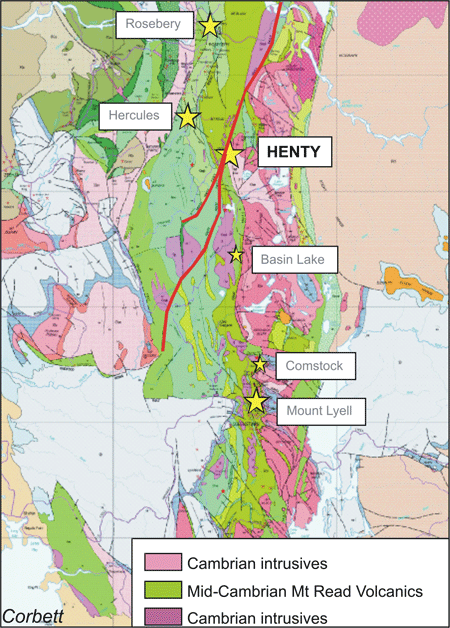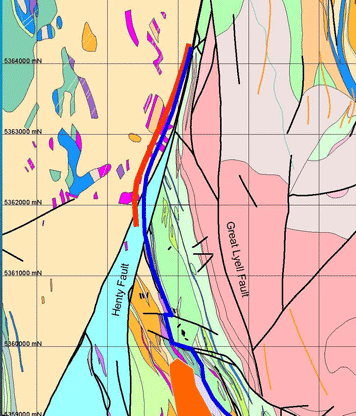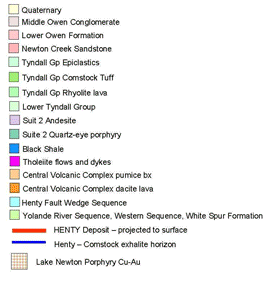Henty Gold Mine – Geology
Regional Geology
The Henty Mine is hosted in the Cambrian Mt Read Volcanics. The Mt Read Volcanics are an arcuate belt of acid to intermediate volcanics occupying the eastern margin of the Dundas Trough. They are bounded to the east by Precambrian basement rocks of the Tyennan Region and younger Cambro-Ordovician siliciclastics and appear to interfinger with fossiliferous volcanosedimentary rocks of the Dundas Group and Western Sedimentary Sequence to the west.
A major north south striking structure, the Henty Fault, divides the Mt Read Volcanics into two parts, north and west of the Henty Fault and south and east of the Henty Fault. Within the Henty Fault are rocks of the Henty Fault Sequence to the south of Mt Murchison, and the Farrell Slates to the north near Tullah. The Mt Read Volcanics north and west of the Henty Fault host the Pb-Zn rich polymetallic volcanogenic massive sulphide (VHMS) deposits of Rosebery, Hercules, Que River and Hellyer, while the volcanics south and east host the Henty Gold Mine, Mt Julia Prospect and copper-gold deposits of the Mt Lyell Field. The Mt Read Volcanics south and east of the Henty fault are divided into four lithological groups;
- Central Volcanic Complex (CVC) consisting of mainly rhyolitic to andesitic volcanics with minor sediments and mafic units.
- Eastern Quartz Phyric Sequence of quartz porphyritic lavas and volcaniclastics.
- Tyndall Group comprising mainly quartz-phyric felsic and intermediate extrusives and volcaniclastics with interbedded epiclastics.
- Western Sequence of volcanosedimentary siltstones, shales, quartzose and volcaniclastic turbidites and felsic porphyry intrusives.
The oldest rocks belong to the CVC and Western sequence. The CVC is thought to underlie and partially interfinger with the Western sequence to the west, and the Eastern Quartz Phyric Sequence to the east. Recent investigations on the South Henty EL suggest the CVC overlies the Western sequence in this locality. The Tyndall Group overlies the CVC both conformably and unconformably. Overlying the Mt Read Volcanics are the Cambro Ordovician siliciclastics of the Owen Conglomerate which have an unconformable to interdigitating relationship.
The NNE trending, 70 degrees west-dipping Henty Fault dominates the Mt Read Volcanic Belt for at least 60 km. The Henty Fault divides into the North and South Henty Faults near Mt Read. The Great Lyell Fault splays off the Henty Fault somewhere in the vicinity of Mt Murchison and trends in a southerly direction to the south of Mt Lyell. Both of these structures bound the western margin of thick sequences of Owen Conglomerate.
The Cambrian and younger (to early Middle Devonian) rocks in western Tasmania have been effected by widespread Devonian folding of the Tabberabberan Orogeny. The Tabberraberan Orogeny was a multiphase deformation event, with an early phase of NNW folding (D1) and a later NW to WNW (D2) trend recognised in the region. This has produced open upright folding in competent siliciclastic units but tight folding in phyllosilicate rich volcanics. Reverse faulting is common and the rocks have developed a pervasive regional foliation. Metamorphism was of prehnite-pumpellyite to lower greenschist facies.
Local Geology
The geological model for the formation of the Henty gold deposit has changed over the life of the mine. It is currently considered to be a late Cambrian Volcanogenic Hosted Massive Sulphide (VHMS) deposit that has been subsequently altered and overprinted by late stage hydrothermal and structural events.
The Henty Mine Lease geology is dominated by the Henty Fault, a major NNE striking regional structure traversing the Mt Read Volcanics. The Henty Fault divides into North and South Henty faults in the middle of the Mine Lease. The South Henty Fault has a strong south-plunging inflexion in the vicinity of the Mount Julia deposit extending south.
The Henty deposit is comprised of a series of gold bearing, sulphide rich lodes that plunge shallowly to the south and dip steeply to the west in close proximity to the footwall of the regional South Henty fault. Lithologies to the east of the Henty Fault are controlled by a major, shallowly south plunging, asymmetric syncline centred on the siliciclastic rocks of the Owen Conglomerate and the Henty Fault. The western limb of this syncline is steeply east dipping in the south of the lease, but is overturned to the east in the northern and central regions where the synclinal axis trends into the Henty Fault. There are indications of a major dextral movement on the South Henty Fault.
Alteration and mineralisation is strongly controlled by the South Henty Fault, which appears to form the upper boundary to the mineralised zone. Alteration extends several hundred metres down dip from the fault contact before a rapid decrease in intensity.
The rocks that host these lodes appear to be the result of concurrent deposition of both magmatic sourced “cherty” gold-sulphide bearing exhalatives and felsic ashfalls on a shallow sea floor.




